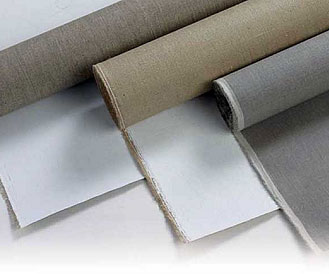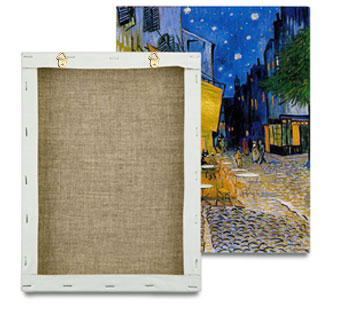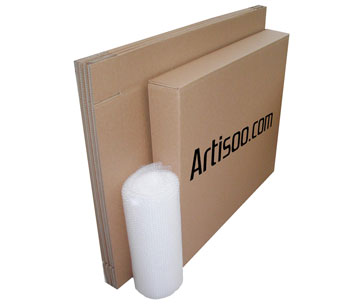

Buying an oil painting from Artisoo is like stepping back in time! Every oil painting we sell is painted by our master artists in the same time-honored traditions utilized by the world's most renowned artists, emphasizing the importance of aesthetics, technique and style. Many of our artists have years of training at some of the finest art academies, specializing in the medium of oil on canvas.
Please read below how our artists, step by step, paint the oil paintings that are displayed on our website. You will learn that at Artisoo gallery , each and every oil painting is meticulously painted, brushstroke by brushstroke, starting with a blank artist canvas and ending with a true masterpiece!

The studio at Artisoo features more than 15,00 square feet of open space where our artists work together to create and recreate masterpieces. This allows us to maintain our high quality control standards. Also, since our customer service group and shipping department are located on the same floor, this guarantees open communication between you and your artist.

 The painting process involves many intricate steps our artists must complete in order to paint each oil painting. Our stringent quality control and high standards of excellence ensures that our artists strictly adhere to our philosophy that every oil painting must be painted with the utmost attention to detail, aesthetics, technique and style. At Artisoo gallery, we want you to buy with confidence, knowing that you have purchased the finest quality oil paintings.
The painting process involves many intricate steps our artists must complete in order to paint each oil painting. Our stringent quality control and high standards of excellence ensures that our artists strictly adhere to our philosophy that every oil painting must be painted with the utmost attention to detail, aesthetics, technique and style. At Artisoo gallery, we want you to buy with confidence, knowing that you have purchased the finest quality oil paintings.
 Our master artists use a wide array of brushes to accomplish their goal of painting the perfect masterpiece for our customers. We insist that our artists use only the highest quality artist brushes, which are always finely balanced for maximum stroke control. Professional artist brushes are made from a variety of fibers to create different effects. In addition, brush heads are available in almost a limitless selection of sizes and shapes, each ensuring our artists will achieve their desired results.
All of the oil paints our artists utilize come together on the artist palette. The artist palette is commonly constructed of very thin wood, designed to be held in the artist's hand while resting on the arm of the artist. In addition to the wood palette, our artists may also use a flat tray that is conveniently located just below the canvas that is being painted. This tray serves a dual purpose as the palette for the oil paints and also a convenient surface to have all the artist brushes close at hand. The artist palette is the surface where all the oil paints are mixed together to achieve the desired colors needed by the artist to complete each masterpiece.
Our master artists use a wide array of brushes to accomplish their goal of painting the perfect masterpiece for our customers. We insist that our artists use only the highest quality artist brushes, which are always finely balanced for maximum stroke control. Professional artist brushes are made from a variety of fibers to create different effects. In addition, brush heads are available in almost a limitless selection of sizes and shapes, each ensuring our artists will achieve their desired results.
All of the oil paints our artists utilize come together on the artist palette. The artist palette is commonly constructed of very thin wood, designed to be held in the artist's hand while resting on the arm of the artist. In addition to the wood palette, our artists may also use a flat tray that is conveniently located just below the canvas that is being painted. This tray serves a dual purpose as the palette for the oil paints and also a convenient surface to have all the artist brushes close at hand. The artist palette is the surface where all the oil paints are mixed together to achieve the desired colors needed by the artist to complete each masterpiece.
 Our artists use canvas that is made from high quality, 100% cotton fabric. Cotton canvas is the preferred choice for our artists, because it is a very durable fabric for oil painting. The fine woven cotton canvas is coated with acid-free titanium gesso, which ensures long term life for our museum quality oil paintings. The 100% cotton canvas has both excellent fiber strength for stretching and is also woven to rigid specifications to meet the strict requirements of our master artists.
Our artists use canvas that is made from high quality, 100% cotton fabric. Cotton canvas is the preferred choice for our artists, because it is a very durable fabric for oil painting. The fine woven cotton canvas is coated with acid-free titanium gesso, which ensures long term life for our museum quality oil paintings. The 100% cotton canvas has both excellent fiber strength for stretching and is also woven to rigid specifications to meet the strict requirements of our master artists.
 The painting process starts out with our artist sketching an outline of the oil painting prior to applying any oil paints to the canvas. Here is where our artist can concentrate on sketching the rough composition of the subject matter, paying special attention to the proper scale of the various shapes and figures that will comprise the finished oil painting. Our artists utilize an assortment of specially designed charcoal pencils to complete the sketch layout.
The painting process starts out with our artist sketching an outline of the oil painting prior to applying any oil paints to the canvas. Here is where our artist can concentrate on sketching the rough composition of the subject matter, paying special attention to the proper scale of the various shapes and figures that will comprise the finished oil painting. Our artists utilize an assortment of specially designed charcoal pencils to complete the sketch layout.
 Here our artist is using a fairly wide artist brush to apply the first coat of paint to the canvas. The first layer of oil paint or "undercoat" is painted to cover the white gesso of the canvas, while also acting to "tone" the canvas. In this step of the painting process, our artist will generally concentrate on the initial application of color, focusing on the most distant background, and then working slowly towards the foreground elements, all the time following the outline sketched on the canvas.
Here our artist is using a fairly wide artist brush to apply the first coat of paint to the canvas. The first layer of oil paint or "undercoat" is painted to cover the white gesso of the canvas, while also acting to "tone" the canvas. In this step of the painting process, our artist will generally concentrate on the initial application of color, focusing on the most distant background, and then working slowly towards the foreground elements, all the time following the outline sketched on the canvas.
 Here our artist will continue to paint the remaining areas of the oil painting with the undercoat of oil paint, while also concentrating on painting the various shapes and forms in the oil painting. Colors are carefully mixed and applied to the canvas by our artist in varying hue intensities in order to achieve the desired depth perspective and color requirements. Before proceeding to the next step, this layer of paint must be allowed to dry.
Here our artist will continue to paint the remaining areas of the oil painting with the undercoat of oil paint, while also concentrating on painting the various shapes and forms in the oil painting. Colors are carefully mixed and applied to the canvas by our artist in varying hue intensities in order to achieve the desired depth perspective and color requirements. Before proceeding to the next step, this layer of paint must be allowed to dry.
 Here our artist is utilizing various artistic techniques to add texture to the oil painting, all the time focusing on the necessary consistency and thickness of the oil paints that will start to give the oil painting its unique character. The deft use of various shape artist brushes and the application of more or less paint on the brush, allows our artist to accomplish the task of adding texture to the oil painting.
Here our artist is utilizing various artistic techniques to add texture to the oil painting, all the time focusing on the necessary consistency and thickness of the oil paints that will start to give the oil painting its unique character. The deft use of various shape artist brushes and the application of more or less paint on the brush, allows our artist to accomplish the task of adding texture to the oil painting.
 An oil painting is not a masterpiece until all the artistic details are incorporated into the oil painting. Every small detail, such as shadows, highlights, shading and color prominence are all vital elements that must be addressed in this step.
An oil painting is not a masterpiece until all the artistic details are incorporated into the oil painting. Every small detail, such as shadows, highlights, shading and color prominence are all vital elements that must be addressed in this step.
 After our artist is satisfied with the completed oil painting, a highly accomplished senior artist will be called in to offer a professional opinion and render the final approval. Only then will this oil painting be called a true masterpiece.
After our artist is satisfied with the completed oil painting, a highly accomplished senior artist will be called in to offer a professional opinion and render the final approval. Only then will this oil painting be called a true masterpiece.


 We only use courier companies such as EMS, FedEx and DHL for all deliveries as they are the safest and fastest shipping method. All shipments are insured and are hand delivered to the shipping address you provide.
Once your order has been dispatched, we'll email you a tracking number so you can track your order. Shipping usually takes 7days or less.
We only use courier companies such as EMS, FedEx and DHL for all deliveries as they are the safest and fastest shipping method. All shipments are insured and are hand delivered to the shipping address you provide.
Once your order has been dispatched, we'll email you a tracking number so you can track your order. Shipping usually takes 7days or less.
 Caring For Your Oil Painting
Caring For Your Oil Painting
Caring for your painting will ensure its longevity. There are preventative measures that can and should be taken when owning an oil painting. Oils are one of the most sensitive means of artistic media, and damages are common. Handling of the artwork, changes in temperature, lighting, hanging, and storage can all cause different types of damage, including:
The cracking of paint, distortions of the canvas, fading and discoloration of the painting
Handling of the artwork too often will inevitably cause damage, so be certain to take preventative measures when moving the painting. Be sure to seal and insulate. In a move, this will prevent destruction from hot and cold temperature changes, as well as bumps and bangs. Bubble wrap your painting even if moving it in a protective portfolio. This way, if the cover is punctured, you still have a safety net.
Changes in temperature will cause your painting to stretch and shrink, just as your door frame does from winter to summer months. This can cause cracking of paint and/or canvas. Some variation is inevitable, but to avoid severe changes hang the painting somewhere in the home or office where humidity and temperature are reasonably constant. Avoid hanging the painting near doorways, windows, and air ducts (this includes fireplaces that are often in use). Bathrooms and kitchens (humidity, smoke, heat) are also a bad idea for your oil painting.
Lighting whether natural or artificial, will have negative effects on your painting in the long term. Never hang your painting in direct sunlight! This will cause fading of the paint, as well as frequent temperature change from day to night, which will cause cracking. Hang the painting on an outside wall (but not near a window) to avoid sun damage. In choosing the correct artificial lighting, try flood lighting or if using spots, use a low frequency bulb, as a high concentration of direct light will have the same effect on your painting as sunlight.)
Hanging Your painting is an important consideration. We've spoken about temperature damage, but you also want to consider 'people' damage. Avoid hanging your painting in an area where people may bump it. Your painting should theoretically be hung at eye level, but in narrow spaces like hallways, a bit higher wouldn't hurt. 8 to 10 inches breathing room above furniture should salvage the painting from mishap. Another consideration is cigarette smoke. If you have a designated smoke area, hang up a poster, this is not where you want your oil painting.
Store your painting with the same consideration that you hang it. Basements and Attics are not your best bet. Temperatures are typically very dry or very wet in these environments. Cover your painting on both sides with bubble wrap or corrugated plastic, box it up in cardboard, and store it in a closet that remains as close to room temperature as possible.
Cleaning your painting is risky. Very lightly and infrequently dusting with a lint free silk cloth or a soft brush may be okay, but it is best to rely on experts and professionals to help with full cleaning and/or repair.